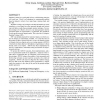Free Online Productivity Tools
i2Speak
i2Symbol
i2OCR
iTex2Img
iWeb2Print
iWeb2Shot
i2Type
iPdf2Split
iPdf2Merge
i2Bopomofo
i2Arabic
i2Style
i2Image
i2PDF
iLatex2Rtf
Sci2ools
ICSE
2008
IEEE-ACM
2008
IEEE-ACM
ARTOO: adaptive random testing for object-oriented software
Intuition is often not a good guide to know which testing strategies will work best. There is no substitute for experimental analysis based on objective criteria: how many bugs a strategy finds, and how fast. "Random" testing is an example of an idea that intuitively seems simplistic or even dumb, but when assessed through such criteria can yield better results than seemingly smarter strategies. For random testing to be effective, however, one must guarantee that the generated inputs are representative; in particular, they should be evenly spread across the input domain. This is the idea of Adaptive Random Testing (ART). ART was initially proposed for numerical inputs, on which a notion of distance is immediately available. To extend the ideas to the testing of object-oriented software, we have developed a notion of distance between objects and a new testing strategy (ARTOO) which selects objects that have the highest average distance to those already used as test inputs. AR...
Adaptive Random Testing | Comprehensive Automated Testing | Directed Random Strategy | ICSE 2008 | Software Engineering |
Related Content
| Added | 17 Nov 2009 |
| Updated | 09 Dec 2009 |
| Type | Conference |
| Year | 2008 |
| Where | ICSE |
| Authors | Ilinca Ciupa, Andreas Leitner, Manuel Oriol, Bertrand Meyer |
Comments (0)

